You also want an ePaper? Increase the reach of your titles
YUMPU automatically turns print PDFs into web optimized ePapers that Google loves.
1<br />
Introduction<br />
<strong>THE</strong> <strong>SYRIA</strong>N CIVIL WAR, which began in earnest at the end of 2011, has<br />
become a regional and arguably a sectarian conflict. 1 Throughout 2012 and<br />
early 2013, claims that Syrian dictator Bashar al-Assad was “losing control”<br />
to primarily Sunni rebel forces were common in Western and Middle East<br />
media sources. 2 Reports streamed in showing that the Assad regime had lost<br />
control of border posts with Iraq and that the embattled leader may even<br />
have lost the support of its key ally Russia. 3 By the spring of 2014, Syria and<br />
Iraq had essentially become a joined front, including thousands of combatants,<br />
millions of displaced persons and refugees, along with the involvement<br />
of multitudes of global actors. Yet at the time of this writing in late 2014,<br />
Assad has not only survived, but forces supportive of his rule have retaken<br />
and secured wide swaths of territory. How did such a feat occur?<br />
Foreign fighters were central to both the rapid turnaround on the front<br />
and the Assad regime’s continued survival. In line with the influx of anti-<br />
Assad foreign fighters into Iraq and Syria, much research and coverage has<br />
focused on Sunni jihadists—so much so that the term “foreign fighter” has become<br />
a virtual synonym for Sunni jihadist. 4 Just as pivotal as the Sunni jihadists,<br />
however, if less frequently covered, are the thousands of Shiite jihadist<br />
fighters who have mobilized in opposition to their Sunni foes. These fighters<br />
have come primarily from Iraq and Lebanon, but also from other countries.<br />
Indeed, what may have appeared to be a disjointed or even organic flow of<br />
Shiite fighters into Syria, ostensibly to defend the country’s Shiite holy sites,<br />
was actually a highly organized geostrategic and ideological effort by Iran to<br />
protect its ally in Damascus and project power within Syria, Iraq, and across<br />
the Middle East.<br />
The aid these Shiite jihadist fighters have provided to the Assad regime<br />
represents just one of their accomplishments. Far more significant has been<br />
the underlying creation and development of new front groups, a trend that<br />
1


